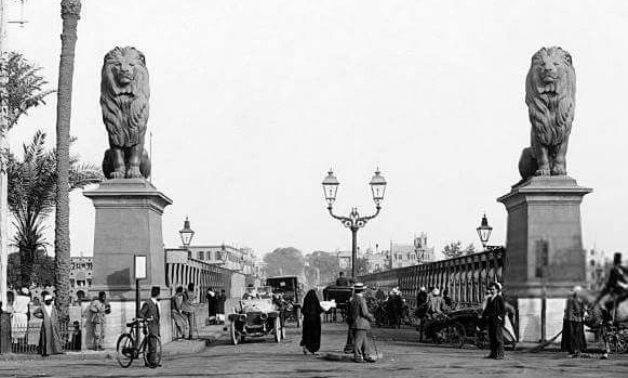
Bronze refracts the sunset, and the lions glare forward into Cairene traffic. Lovers stand hand in hand overlooking the Nile, karkade street vendors unroll their wads of tens and fives, and the day comes to a breathless halt: a Saturday evening in the making.
Braced at either end of the Qasr al-Nil bridge, witnessing all of it, are four daunting sculptures once intended to guard the Giza Zoo: the four Lions of Qasr al-Nil. Brought to life by French sculptor Henri Alfred Jacquemart, the lions were created following the issuance of a royal decree in 1871. They were sculpted in France before being transported to Cairo by way of Alexandria, valued at the time at FR 198 (EGP 4,031).

Despite initially being intended for the Giza Zoo, another massive Khedivial project, the breathtaking nature of the lions saw Khedive Tawfiq change his mind; instead, they became the gatekeepers of his ‘Palace of the Nile’ bridge, to “befit the glory of his father’s name.” Linking Gezirah to Tahrir Square, the lions have been a function of more than just beauty—rather, they have witnessed everything from revolution to mundane routine, political upheaval to celebration.


In the late 19th century, the lions served as toll stations for passing farmers and tradesmen intending to sell their merchandise at Tahrir Square. Although known now as the symbolic center of revolution, the square was once a marketplace where goods and services were exchanged. In her book, ‘Zamalek: the Changing Life of a Cairo Elite’ (2005), author Chafika Soliman Hamamsy describes a vision where lines would form at the foot of the lions, as people prepared to pay their cross-over tax.
Much like all the indiscriminately mundane events, the lions also bore witness to Egypt’s more tragic realities. The funeral processions of countless public figures took place along the bridge, in the sweltering heat and blistering winter months. Al-Ahram notes that, among names such as Umm Kalthoum and Abdel Halim Hafez, were late presidents and heads of state. The most prominent of these figures being the controversial Gamal Abdel Nasser, whose death in September 1970 was cause of polarizing grief.


Similarly, the lions were at the heated heart of the 25 January revolt, wherein roaring revolutionaries took to the streets to topple despot Hosni Mubarak. Many scaled the lions, an Egyptian flag between their teeth and clutched firmly in their hands, calling for freedom.
Unsurprisingly, this event and many others, while profoundly poetic, took their toll on the four sculptures.
Ezzat Salib, director of the restoration of archaeological sites and museums in Greater Cairo, described the state of the lions as suffering from erosion, graffiti, and calcification from being polished and painted over the years. The graffiti, along with various layers of paint, had to be removed using nano-technology to “consolidate the bodies” in the latter half of 2016.
Accordingly, while there is glamor to calling these sculptures guards and gatekeepers, there is a need to remember that they are only symbolically so; the Lions of Qasr al-Nil are helpless to causeless destruction by both time and people alike. “Ready to roar” as they may look, they cannot defend themselves.
“Who will guard the guards?” becomes more and more relevant to these unique, timeless pieces of heritage.






Comments (2)
[…] those who have the endurance to go on long walks, sauntering down Qasr Al-Nile bridge is a treasured Egyptian experience. Connecting downtown Cairo to Zamalek, the bridge is a […]
[…] مشاهدة القاهرة: كيف رأى أسود قصر النيل كل شيء […]